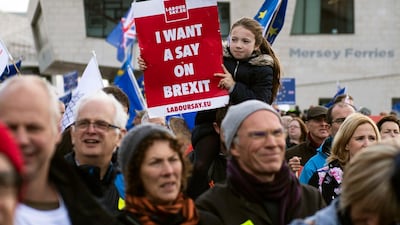As a strategy, “constructive ambiguity” sounds like an ornate euphemism for “sitting on the fence”, but this is the label some have applied to the Brexit position of the UK’s opposition Labour party.
Of course, the party itself is not openly calling it constructive ambiguity, as it tiptoes around the increasingly desperate negotiations between Theresa May’s government and the EU, and time rapidly runs out before the the UK’s deadline to leave the union in six months’ time. But Labour’s Shadow International Trade Secretary Barry Gardiner gave the game away on the eve of the party’s annual conference in Liverpool last week, responding to a challenge from a disgruntled former Labour politician that her “once-great party” was completely silent on Brexit, while the government plunged the country ever deeper into crisis. Gardiner replied, quoting Napoleon Bonaparte: “Never interrupt your enemy when they are making a mistake.”
The Labour party has been in an awkward position on Brexit from the very beginning. It didn’t want a referendum to be held in the first place, and while 65 per cent of its voters chose to remain in the EU in June 2016, about 60 per cent of Labour-held parliamentary constituencies voted to leave. The members of the party’s left-wing leadership had always been critics of the EU’s free-market principles, and while leader Jeremy Corbyn dutifully campaigned for remain with the rest of his party, he was only “about seven out of 10” behind it, as he told the BBC at the time.
Since the Brexit vote in June 2016, the Labour leadership's position has been even more of a tightrope walk: cautious about being seen to oppose the will of the people, they are nonetheless alienating many of their supporters and even some of their own politicians, who want to see the referendum overturned, or at least re-run. Meanwhile, Mr Corbyn's team are, of course, unable to get anywhere near the negotiations themselves − even though, given the febrile atmosphere in Theresa May's party, there's every chance that, perhaps as soon as next year, they will be the ones stewarding the deal the Conservatives are pursuing.
Labour’s official policy response, set out in March 2017, has been built around “six tests” for the government’s Brexit deal: these include “a strong and collaborative future relationship with the EU”, and maintaining the “exact same benefits” the UK currently enjoys as a member of the customs union and the single market. The party’s position has been to leave Europe – to respect the result of the referendum – while remaining as close to its institutions as possible. The Conservatives’ more hardline attitude to Europe being what it is, it was always impossible that Mrs May would produce a deal that met those criteria.
All this ambiguity has felt rather less than constructive for a lot of remain-voting Labour supporters. There was even a thousands-strong March for a People's Vote in Liverpool on the opening day of conference, seeking to persuade the leadership of the need for Brexit to be stopped. Even at the party conference itself, senior Labour politicians were at odds: Mr Corbyn's closest ally, Shadow Chancellor John McDonnell, ruled out a remain option being on the ballot paper in any putative second referendum in the spring – any public vote should simply be "yes" or "no" to the government's deal, he said. The very next day, the party's Shadow Brexit Secretary Keir Starmer brought the conference crowd to its feet by saying that "nobody is ruling out remain as an option".
In so doing, Mr Starmer brought relief to the People's Vote crowd, but angered some fringe elements in the party. One Labour-affiliated trade union chief, Fire Brigades Union chair Paul Embery, said Mr Starmer was in danger of casting the party in the role of traitor to the working-class, leave-voting “heartland” communities of England’s northern and Midlands regions. “With every speech we are confirming our status as a middle-class, London-centric, uber-liberal, youth-obsessed party,” he said.
Meanwhile, alongside the official conference in Liverpool, at the 10,000-capacity left-wing festival The World Transformed, it was telling that few attendees were discussing Brexit at all. Among this activist nucleus of Mr Corbyn’s support, and many members of the party’s affiliated trade unions, the conversation was focused on how they might build a socialist country after Brexit, rather than stopping it from happening in the first place. Ironically, this event featured numerous activists and politicians from across mainland Europe, who were there to share policy ideas and experiences.
In spite of the angst of some and the weariness of others, in keeping all possibilities open, Mr Starmer’s speech seemed to reassure a lot of Labour’s base. Alongside it, an intense collaborative effort involving Mr Starmer and more than 100 different local Labour parties and trade unions produced a compromise Brexit motion that most sides seemed to be equally happy (or unhappy) with. Such are compromises, after all. “If we cannot get a general election, Labour must support all options remaining on the table,” reads its key passage.
When something as chaotic and unpredictable as Brexit throws up more unknowns than a Donald Rumsfeld speech, ambiguity can sometimes make sense.
Dan Hancox is a journalist and author living in London

